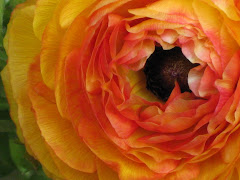But plants are a different story. I take in orphan plants and give them a home. (I don't actually name them, the Latin is enough.) My own garden's design is such that there will always be room for the plant escaping an early death. A client had several Hydrangea quercifolia, Oakleaf Hydrangea, that had been crushed by a falli
 ng limb during a thunderstorm. They were essentially missing an arm and two legs, fairly misshapen and surely not worthy of a front garden. The plants were not dead, just in need of a year or so of rehab, which I kindly offered them. Today, I made the rounds to check on my rehab patients and was pleased to see their progress. All have new leaves emerging -- and how appropriate for Easter -- unfurling like little hands folded to pray as the days warm.
ng limb during a thunderstorm. They were essentially missing an arm and two legs, fairly misshapen and surely not worthy of a front garden. The plants were not dead, just in need of a year or so of rehab, which I kindly offered them. Today, I made the rounds to check on my rehab patients and was pleased to see their progress. All have new leaves emerging -- and how appropriate for Easter -- unfurling like little hands folded to pray as the days warm.I even take in orphan plants from the nursery. Technically, they haven't been abandoned but rather just up for adoption and like human adoptions, there's a little c
 ost involved. Sometimes I think I understand the California woman who had octuplets this spring: I just cannot have one and wonder about the many others left behind for uncertain fate! I want as many as will fit on my cart, or in the back of my very large SUV (a lot). Today, I adopted a nice brood to fill some bare spaces and containers while I await the return of some late spring perennials.
ost involved. Sometimes I think I understand the California woman who had octuplets this spring: I just cannot have one and wonder about the many others left behind for uncertain fate! I want as many as will fit on my cart, or in the back of my very large SUV (a lot). Today, I adopted a nice brood to fill some bare spaces and containers while I await the return of some late spring perennials.Here are some helpful hints for great looking containers:
- Use a variety of colors, textures and sizes (the tallest being no more than the height of the pot). Experiment!
- Select a color scheme, sticking with either a warm/hot palette (reds, oranges, yellows) or cool palette (blues, purples, bit of yellow), using white and green as neutral.
- Make sure the plants require similar sun exposure (i.e., don't mix shade plants with sun plants no matter how awesome the will look together - it won't last) and that they will thrive in the location the pot is placed (i.e., don't put shade-loving plants in a pot that will bake on the patio).
- Pack in the plants! Typically, pots are filled with annuals with a short bloom season and don't have time to grow and fill out like the perennials and shrubs in the garden. Put as many plants into the container as possible (keeping their soil around the roots) for instant beauty!
- Give the plants a good start with good potting soil, some organic slow-release fertilizer and plenty of water. It's also a good idea to replace the soil in older pots every couple of years -- just spread the old dirt in another spot in the garden.
- Water, water, water -- every day if it does not rain, and in the morning so the roots have time to absorb the water and are not boiled in the afternoon heat.



Ok..I have a garden question. My tomato plant took on too much water when it rained the other day. Will it survive? It is droopy and doesn't look so well. I have cut off all yellow limbs and leaves and replanted it in some dryer dirt but I am worried about my little friend(he survived the Hurricane) what else can I do?
ReplyDeleteContinue to remove any yellow limbs or leaves, a sure sign of too much water. How long after the rains stopped did the plant start to turn yellow?
ReplyDeleteI'd also look closely at where it is planted -- you have somewhat sandy soil that should drain quickly -- is the tomato plant in a location that is slightly lower that the rest of the area around it (meaning is the regular rain water collecting near it). You can make a little mound of dirt an inch or two higher than the area around and then plant the tomato back in the built up area.
Two days later I saw yellowing and yeasterday is when I replanted...I will build up the area more...but I am afraid for the seven tomatoes already developing...
ReplyDeleteyesterday..hello?
ReplyDeleteIt is official! The tom.plant survived! It had two major surgeries and one transplant and it is growing new fruit! It is bare and being protected now by some Ginger until it has its leaves back but it feels strong(just glad I didn't have to donate it to the composte!) Thanx!
ReplyDelete~F